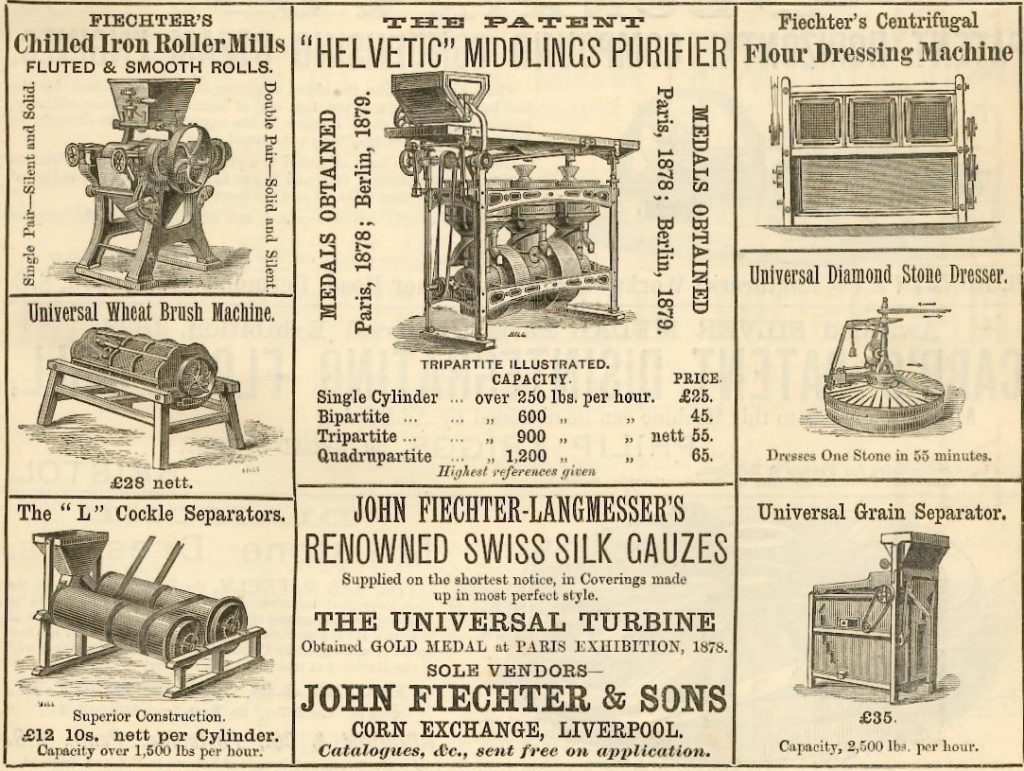Journals: The Miller

The Miller was a British journal founded by William Dunham in March 1875. It was published in the Mark Lane area of London and was the first proper milling journal to be published in Britain. The first edition wrote about the ‘absence, in this country, of a “class” journal exclusively devoted to Millers’ and this publication was created to fill that gap (The Miller, p.1).
Two forms of this journal were published: a Technical Issue on the first Monday of every month, and a Market Issue published every Monday evening. They contained a variety of content from articles on mills, millers, and machinery; advertisements; and a section where questions could be answered. This meant that British millers now had a way to learn and ask about the technical advancements being made in their industry and see examples of how such machinery was being used. The advertisements were predominantly for engineers and firms producing roller machinery. This included bigger firms, such as Henry Simon Ltd., and smaller or local firms, like Whitmore and Binyon. However, adverts were not exclusively for machinery. Indeed, advertising exhibitions and events was almost more important than advertising the machinery itself as it was arguably thanks to exhibitions that roller milling succeeded in Britain.

Within The Miller, there was also a way to make your voice heard through the ‘Letters to the Editor’ section. It was in this section that their original aim that columns of the journal should ‘be freely open for all the interchange of opinions’ can best be seen. Anyone could write a letter to the editor and then it might be published. When opinion differed on a topic, it could lead to arguments that could stretch over many months. One such argument, or debate, took place in the spring of 1882. In 1880, Mary Ann Yates founded the Bread Reform League and two years later, would find herself in a written debate with the engineer and roller mill manufacturer, Henry Simon. On 6 February 1882, a letter was published by Miss Yates with details on how millers could send a sample of their ‘finely-ground wheatmeal’, providing that it had been ‘properly prepared’, to their upcoming meeting. Whilst this letter was not inflammatory, the next month a letter could be found by Henry Simon attacking the Bread Reform League and their ‘set of circulars’ that had recently been received. He attacks them for trying to discredit white wheat breads and questions whether any of their claims that ‘indigestible bread devoid of flavour and nutriment begets a craving for stimulants’ were scientifically based. This sparked responses by both Miss Yates and Katharine Jane Dance, the Late Hon. Teacher of the London Bread Reform League, claiming scientific proof and the good qualities of wheatmeal bread. However, it was Henry Simon who had the final word in this argument when on 5 June 1882, his response was published:
‘The result is that by their own acknowledgement, and, notwithstanding their several years of agitation, with the help of twenty-four duchesses and fifteen medical men in London, they cannot yet say that any one in England produces the flour as they desire it. Now I should like to know whether it is right that an agitation should go on for years, and people be left in the belief that they are eating an article worth agitating for, if at the end of several years this article, by their own admission, cannot yet be produced? It seems to me that further comment is unnecessary.’
This may have ended this debate in The Miller, but not in the wider world as the Bread Reform League lasted well into the 20th century. This both highlights an important issue from the milling world but also serves to demonstrate the importance of The Miller in providing a public forum where debates were raised and individuals had a voice.
So, The Miller was a successful trailblazer in Britain and their hope, as stated in their very first edition, was fulfilled: ‘We believe that adventure will meet with the encouragement we hope for, no effort of our shall be wanting to make this publication worthy of its name and to the interest of every Miller and all connected with this important branch of trade, to support, subscribe, and with success to this “class” journal’.

